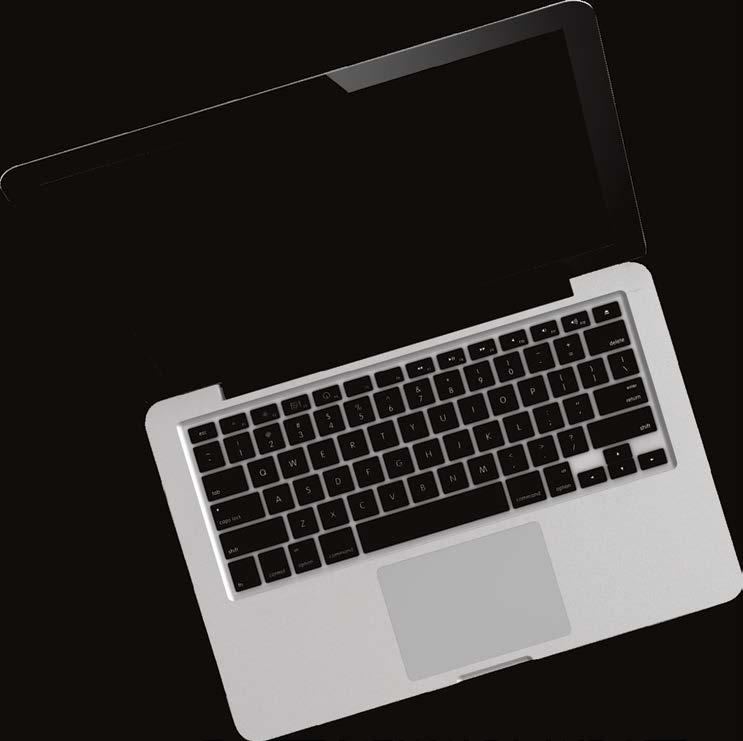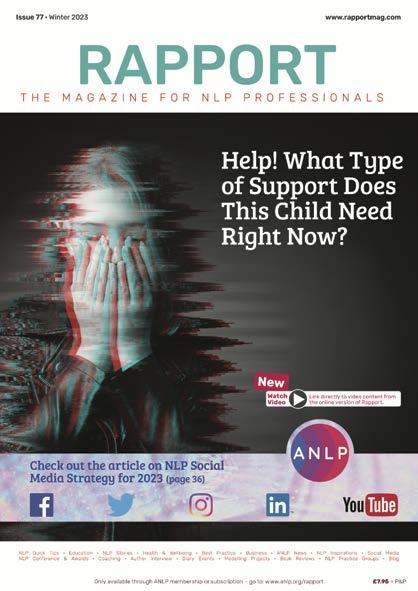



























eve@selfcarecoaching.net www.selfcarecoaching.net
Do you remember your early NLP training around giving feedback by noticing a positive, then an area for improvement and then another positive? Sometimes known as a ‘s**t sandwich’?
Attempting to see everything as information and to not argue with reality helps me take some of the charge out of heated situations, especially when it comes to setting and maintaining healthy boundaries.
I’ve supported clients with boundaries for nearly 20 years but still sometimes struggle myself. Knowing this is normal definitely helps, as does a strategy I recently heard about.
Brene Brown says “Clear is kind.” Even when I don’t relish the idea of making something potentially unpleasant clear, I know it is ultimately kind. Brown advocates ensuring people know that all the feelings are welcome but certain behaviours are unacceptable.
It can help us recognise that anytime any of us start setting boundaries (aka giving people the feedback that something they’ve got away with for however long is no longer going to be tolerated), even the most innocuous request will likely feel demanding. We can be patient and compassionate as we build these emotional muscles.
Melissa Urban, talking about boundaries on a recent Glennon Doyle We Can Do Hard Things podcast episode, made it clear that even she still struggles, having written a book about them. She offered a traffic light system to help give a sense of the spectrum


available rather than going in with guns blazing.
The traffic light system suggests using green as a starting approach, assuming the intention is not to hurt or be disrespectful, and making it really easy for the person to accept the consequence you’re laying out.
Some potential green ways of offering potentially unwelcome feedback in the form of a boundary might include:
• “I can’t see your payment for ____. Could you check the records at your end, please?”
• “When you _____, I don’t have time to _____ and I think you then feel unwelcome when you arrive. Could you message me a bit earlier please, so I’ll be in a better position to properly welcome you?”
• “When you didn’t _____, I felt ______. I don’t imagine you meant for me to feel ____ but it hurt. It’d be really helpful if you _____ next time. How does that sound?”
Then we move to Happily Ever After where, having been so brave as to set your boundary in spite of hating giving that potentially negative feedback, the person on the receiving end is all, “Wow. I had no idea! I’ll do better forever more and we’ll never have any conflict again!”
Except life is not a fairy tale and people who’ve been used to overstepping are unlikely to welcome your newfound self-respect quite so easily.
By embodying your authority and sticking to whatever consequences you’ve warned them about if they don’t honour the green boundary, you’re teaching them new, better ways to treat you.
Amber might be:
• “I still haven’t received payment for ____. As noted on the invoice, there’s a late payment charge which is now also due…”
• “I didn’t hear from you with enough time to prepare. I am sorry to have missed you.”
• “You did _____ again. I care about you and for my own wellbeing, so I am going to take some space.”
And if that doesn’t work, Red might be:
• A letter notifying them of the next steps, which may involve a debt recovery company or small claims court.
• Not letting other people’s poor planning become your emergency even when it feels like you have to do something.
• Further distancing yourself or completely ending the relationship.
Think about a situation that you’re struggling with at the moment in terms of something you know you need to express to someone.
What would be your default mode? Not speaking up until you explode with an instant red response?
How might you go in more green? Where might you amp things up to amber or red?
How can you reframe things to focus on consequences (what you will do if ____ happens again) rather than in an attempt to control them (saying they can’t __)?
We can be patient and compassionate as we build these emotional muscles.
phil@philparker.org www.philparker.org
In the NLP conference 2023 masterclass I’ll be exploring some key techniques for developing Inner Wisdom (IW). IW is best described as the quality of being able to make choices based on knowing what is right for you and that requires some important skillsets. The first is being able to understand situations clearly by focusing on what is occurring in the here and now rather than being driven by unhelpful past experiences. Second is tapping into your deep resources of inner guidance and your immense capacity for change. Third is channelling your ability to pause, reflect, and make thoughtful decisions that ensure your actions fit with what you want to achieve in life.
In this article, abridged from my book on Inner Wisdom Techniques, out in 2023, I’ll be exploring the concept of ‘Gateway States’ that is so central to developing IW.


As NLP practitioners, we are familiar with states. We recognise there are two main state-based issues that affect many people (and that includes us from time to time):
• We are often unaware of when we’re in the wrong state, and
• Many of us don’t know how to move, by choice, into a better state.
Arguably, much of our NLP work helps clients develop this awareness and this state-changing skill set. You may also have noticed that, although there are many possible states, clients often require more access to a sense of calm, confidence, motivation or perspective to work through their issues. These states are awesome at helping change but, when combined with Gateway States, which provide an extra ‘something’ that enhances that change process, change becomes easier and even more accessible.
I first came across them when working with people who had experienced something almost magical at a moment of profound change in their life. Accessing these specific states seemed to transform what happened next. They redrew their map of how easy change could be, and how they felt about themselves and their future and, often, their whole worldview. It was almost as though these states were a catalyst for change or a wormhole that provided a shortcut from one phase in their life to another. Sounds interesting, right?
Due to the limited space here, I’d like to explore four of the seven Gateway States along with a starter exercise to get in touch with them. We’ll cover them in more depth in the masterclass.
In a previous article, I described my journey through recovering from a serious hand injury. Along that road, while being presented with medical opinions telling me there was no way to get movement back in my hand, I had to find a way to stay open to the possibility of recovery, trusting myself, and that I could find a way. This first Gateway State is that sense of deep trust in ourselves and is often combined with a sense of knowing that things are unfolding in the way they should and that we can sense some greater plan at work.
When we get in touch with this trust, it allows for a deeper
It makes obstacles feel like they are just part of the journey rather than being a dead end or a full stop.Introduction to Inner Wisdom Techniques (IWT) for Health and Happiness with Dr Phil Parker Watch Video
sense of our potential for change. Our direction onward becomes clearer. It connects us with what we know is deeply important and our big life goals and sense of purpose or ‘mission’ become clearer. Trust allows this ‘mission’ to become our guide to all that we do. It makes obstacles feel like they are just part of the journey rather than being a dead end or a full stop. As a result, the future feels like something we can flow and dance through because we have a constant centre, a solid certain place to come from. It means that it doesn’t matter how things shift and change around us; whether the path to our goal is straight or winding, we know, when we are connected to trust, that there will be a way and we will find it.
This second Gateway State of being kind to yourself is essential to our health, happiness and success. It is often used to mean the same as self-compassion, although technically self-kindness is defined as one of the three elements of self-compassion (the other two being, first, a recognition of the shared human experience – realising that this is not just happening to me, that we all go through difficult times; and second, mindfulness – being able to observe our emotions in an accepting way yet not being swept away by them). Developing self-kindness has been found to be linked to reducing our response to stress 1 . Doing this has many health consequences, positively affecting brain function, heart, digestive and immune system health and reducing addictions, habits and substance use 2–5
Yet being kind to ourselves is a skill that is deeply unfamiliar to many people. There is a question I’ve used for many years that I think identifies this issue well. It is, “If you treated your friends as you treat yourself, would you have any?” For many people, the answer is no. If they spoke to other people in the same way they speak to themselves, their friends would run a mile and they would probably be sacked from their jobs for being unpleasant towards their colleagues. So, if a client is being hard on themselves, or if you’ve been treating yourself with less kindness than you would show to somebody you care about, then this Gateway State will be invaluable.
We’ve all seen practitioners who are incredible when working with their clients but don’t find the time to apply the same
amazing skill sets to themselves, putting themselves at the bottom of the kindness pile, having no me time etc. Imagine how much easier changing things would be if we could bring a deep sense of self-kindness to any errors, mistakes or missteps we made as we work through the stuff of life. If we can bring kindness to old unhelpful patterns we see in ourselves and in the reactions of others, how would that help smooth our path on that journey?
Curiosity is one of my favourite Gateway States. It describes that state of mind we get into when we’re intrigued by something new. We’ve suspended our judgement about what we think we’ll find, and we’re open to whatever we discover. It’s the opposite of having a fixed mindset, where we feel we already know how everything is or where we have prejudged how something will be.
Curiosity is particularly valuable when we find ourselves dealing with something unexpected that gets in the way of our plans. Quite often, we will respond to these unexpected events as failures or something being wrong. We may feel stuck, blocked, criticised or that we’ve been made to look bad. This is where getting into the Gateway State of curiosity provides such a powerful shift in perspective. It allows us to step away from the trap of expecting things to be a certain way and being annoyed that they are not. Instead, curiosity makes us intrigued about what new pieces of information may appear that show up a portion of the world that is unfamiliar to us, that is filled with innovative perspectives and unexpected opportunities.
It’s something that Adam Grant, Wharton professor at the University of Pennsylvania says that some experts may need to embrace more. He argues that the more familiar we become with our field, the less we might see new and unexpected things. He considers that two of the most important skills we can have are those cornerstones of curiosity: the ability to rethink and unlearn.
The Gateway State of shift is a simple one to understand and incredibly powerful to use. It describes that moment when suddenly everything changes. Where you have a sense of a door opening to a whole new future or that a switch has been flicked

Curiosity is particularly valuable when we find ourselves dealing with something unexpected that gets in the way of our plans.
on. Suddenly, the world feels radically different, and everything that was stuck is now in flow. It’s that vibrant experience of everything being possible.

When we experience life from the Gateway State of shift it reminds us of how much infinite possibility there is in the world. How we are powerful agents of change and how what we do does make a difference. Just by connecting with this state, our neurology and filters of perception become awake to the possibility of something completely different showing up. There are so many examples in everybody’s life of this. It might be the extraordinariness of having a baby, embarking on a brand-new career, moving out of an old stifling relationship, starting a new adventure, uncovering a spiritual realm to your life, recovering from a serious illness, coming across some wisdom in a book, film, song or conversation that makes you feel completely different about your life.
I’m hoping as you’ve read these brief descriptions of these Gateway States that they’ve sparked and awakened something in you, as they have in so many others. They provide a great vacation from some of the more usual types of states we can habitually find ourselves in, such as self-doubt, self-criticism, boredom, difficulty, and impossibility.
At the conference, we’ll be exploring techniques that use these states to help make powerful change, but to start I recommend this brief exploration exercise. Choose one of the Gateway States that you feel called to today. Spend 10 minutes transporting yourself back to a moment from your life when you felt this extraordinary quality showing up. Relish those feelings, sensations, and shifts in perspective. Connect with that sense of possibility that comes from stepping into a world filled to the brim with this. How does that make things different?
1. Rockliff H, Gilbert P, McEwan K, Lightman S, Glover D. A pilot exploration of heart rate variability and salivary cortisol responses to compassion-focused imagery. Published online 2008:9.
2. Davidson RJ. Alterations in brain and immune function produced by mindfulness meditation. Psychosom Med. 2003;65(4):564-570. doi:10.1097/01.PSY.0000077505.67574.E3
3. Parker P, Banbury S, Chandler C. Efficacy of The Rediscovery Process on Alcohol Use, Impulsivity and Flourishing: A Preliminary Randomised Controlled Study and Preliminary Cohort Study. EJAPP. 2020;4(13). doi:https://www.nationalwellbeingservice.org/volumes/ volume-4-2020/volume-4-article-13/
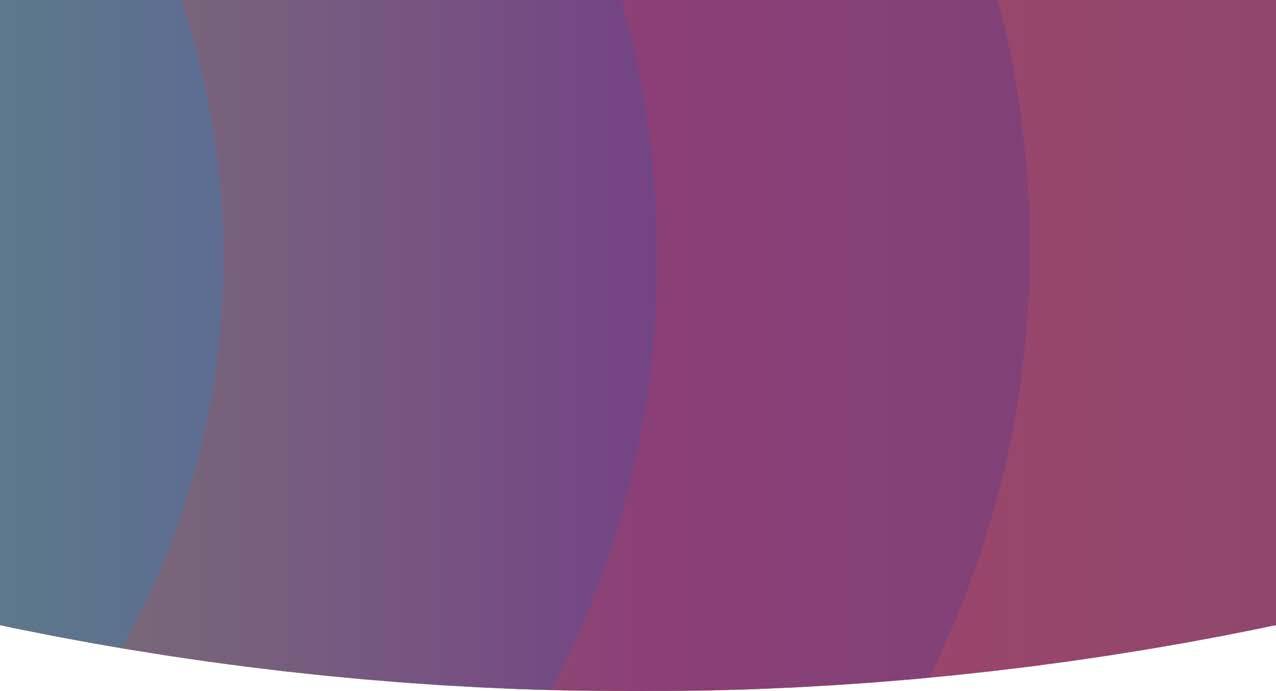
4. Ditto B, Eclache M, Goldman N. Short-term autonomic and cardiovascular effects of mindfulness body scan meditation. Ann Behav Med. 2006;32(3):227-234. doi:10.1207/s15324796abm3203_9
5. Zeidan F, Johnson SK, Gordon NS, Goolkasian P. Effects of Brief and Sham Mindfulness Meditation on Mood and Cardiovascular Variables. J Altern Complement Med. 2010;16(8):867-873. doi:10.1089/acm.2009.0321
When we experience life from the Gateway State of shift it reminds us of how much infinite possibility there is in the world.




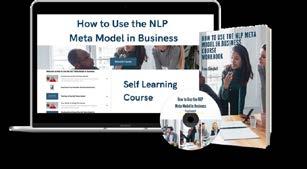

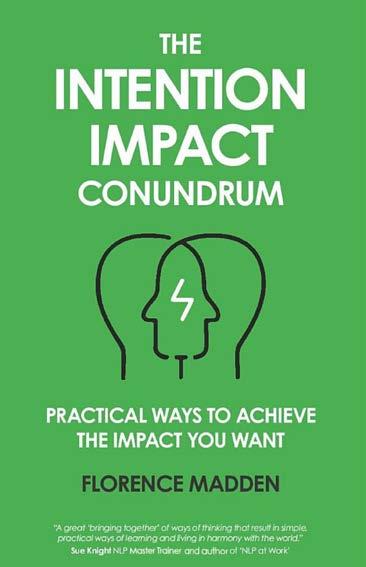
info@florencemadden.co.uk www.florencemadden.co.uk
Iam not the kind of person who writes books! That was my standard reply to delegates on my Personal Effectiveness at Work courses who suggested that I “write this stuff down”. On reflection, I gave no thought to what sort of person actually does write books… nor indeed why I couldn’t be one of them!
I spend a lot of my time on training courses with my hands held apart, demonstrating that there is often a gulf between our (usually good) intentions on the one hand, and the impact we make on the other. Delegates often express frustration with why others don’t get them, why they are misunderstood.
This conundrum is so often at the centre of the work I do with others, particularly so on my Personal Effectiveness at Work course, where I blend NLP with Transactional Analysis and other approaches to help delegates get some insight into the impact they are making on others and what they can do to get the outcomes they want. In fact, I often quip to delegates that I am not ‘pure’! By that, I mean when I am running courses (other than NLP certified courses), I draw on the work of non-NLP professionals, such as Nancy Kline’s Thinking Environment and Carol Dweck’s work on mindset, to mention but two.
So, my book reflects this blend of approaches and draws on these different strategies to address this central question of how we can shift our thinking and hence our behaviour to make our impact meet our good intentions. Given that this blend is to help delegates get some perspective on the attitudes that may be holding them back from doing things differently or doing new things, it gave me pause for thought to reflect on my own initial fixed mindset on what sort of person writes books!
So, what changed that mindset? Well, I have ANLP and my late friend Eleni Sarantinou to thank for that. In 2017, when I was invited to present my ideas at the 2018 NLP Conference, Eleni simply said: “Well, you will have to write the book now!” and that was the start of the adventure!
Ah, but how to make a start… On one occasion over lunch, my friend Jill enquired how the writing was going. I told her confidently that whilst I hadn’t actually written anything yet, I was squirreling away loads of ideas. In a

withering reply, she retorted that squirrels lose about 90% of the nuts they hide. So, I knew I had to make a start… As Goethe suggests, “Whatever you can do or dream you can, begin it; boldness has genius, power, and magic in it.”
In our book Everyday NLP, Eleni remarked that “it takes a village to write a book” – but when I started, the village seemed deserted. Then people began to emerge with advice on structuring chapters and, crucially, a self-publishing contact who would help with the design of the book, do the typesetting and get the book across the line to publication. And then came my unpaid editors – clients who had become friends, who took time to read each chapter and give me their sometimes blunt but loving feedback. One person actually took up most of her Christmas holiday to read it through (thank you again, Maureen!).
It was still down to me to do the writing though, and I came to realise that my reluctance to start was that I didn’t know how to find my voice. I had this idea that there must be a ‘right way’. Anyway, in the absence of knowing the ‘right way’, I asked myself: “What do I want to say?” and the questions I wanted to answer became the working chapter headings and the frame of the book. (I assured myself I would rename these later in a much more author-ish way.)
When I finished the first chapter, it was just after I had been on a course with John Grinder and he kindly agreed to give me some feedback. When he did, it felt brutal – I was not expecting a laurel wreath but still, I felt wounded and sorry for myself that he should find it wanting. I shared my hurt feelings with Eleni, who, instead of sympathising, laughed uproariously (for some time, actually). When I complained to her about her lack of understanding, she said: “John Grinder took time to read your chapter and then give you extensive feedback and advice –and you are complaining?”
Although the original idea was to ‘write this stuff down’ as a resource for others, the real beneficiary was me.Florence Madden The Intention Impact Conundrum Florence Madden Watch Video
I cannot remember if she added “Get over yourself!” but if she didn’t, it was certainly an excellent reframe! So, on I went with the writing process.
In the midst of the developing book, I really started to enjoy it. To write each chapter I had to deepen my knowledge of the subject matter, and, oddly, I felt that if it never got published it was still something I knew I would be glad I had done. Indeed, there was a part of me that didn’t even want to publish it. Publishing meant that my ‘voice’ would be out there and although I was nervous about that to begin with, it suddenly occurred to me that no one was obliged to read it and if they didn’t like it – so what? Of course, I wanted people to like the book and find it a useful resource, but now it was more important that I was being true to myself and what I wanted to say. And those working titles for the chapters? I decided they were my questions and so my voice
too, so they stayed un-authorish and unpolished.
I suppose the irony is that although the original idea was to ‘write this stuff down’ as a resource for others, the real beneficiary was me. Not financially (yet), but shifting my own mindset in writing it at all, as well as taking me into a world that I would never have known otherwise. The experience has shifted my view about what I can do and serves as a useful reflection when working with others who do not see what is possible for them at that moment. As a trainer, it is an invaluable reminder that we are all on a learning journey, even though we may be at different points on the road.
And there was more to come. In the last few months of writing, I had a conversation with Eleni where I (jokingly) suggested we write our own NLP book
as pre-course reading for our courses. Eleni took my joke seriously and I finished The Intention Impact Conundrum on 31st December 2017 and started work on Everyday NLP on 1st January 2018. And co-writing with someone else was the start of a whole new learning experience!
The Intention Impact Conundrum was published in the spring of 2018 with a green cover, which is a tribute to my late brother Charlie McCartney, a rugby player of some repute who played in this colour for City of Derry in Northern Ireland. I have since been invited onto BBC local radio to talk about my experience of writing the book. When the interviewer asked me how it all came about, I replied: “I am an accidental author really – I never thought I would do it, it wasn’t part of a plan – but here I am!”
Yet the opportunities afforded by the whole experience, both personal and professional, have just kept on happening!

This experience has shifted my view about what I can do and serves as a useful reflection when working with others who do not see what is possible for them at that moment.
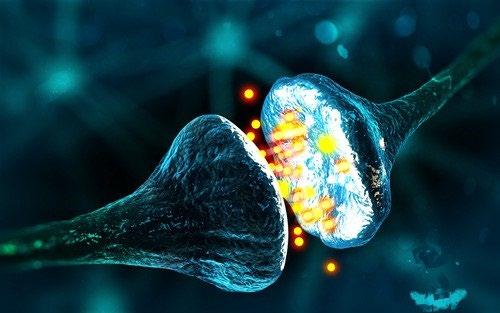
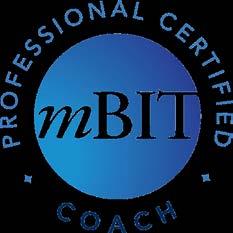
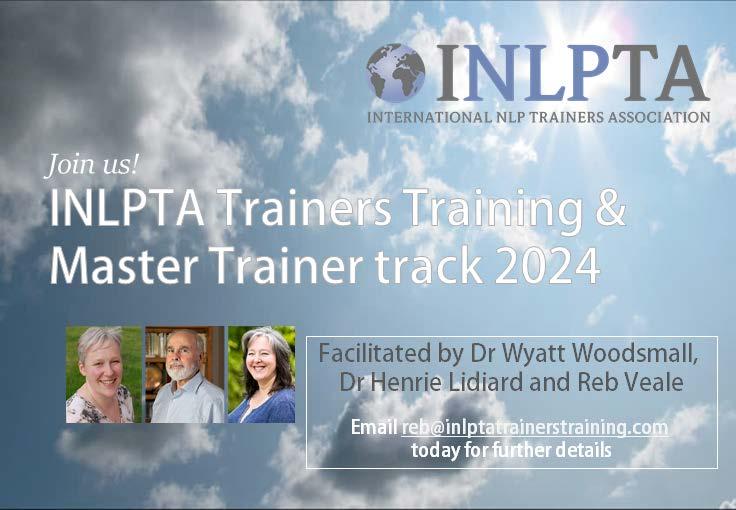

www.anlp.org/members/ geoff-duncan
The following case is a real case of mine, but I have altered the client’s name.
John had got himself into a difficult situation in his workplace and had been encouraged to accept a place on his employer’s coaching programme, which would consist of six coaching sessions. John accepted the opportunity because of the likely prognosis for his employment, even though he had a poor understanding of what coaching was and a low level of belief that coaching could offer anything helpful to him.
Given this context, the initial session centred on building rapport and, given his reluctance to talk about his immediate workplace issue, he was invited to share more about his life more broadly. Noticing his physiology and language as he spoke, some valuable clues to his map of the world and what resources he had available to him became apparent. The session concluded with John saying he had lost his mojo around his personal and professional life.
This loss of mojo showed up in multiple ways. As a professional working for a public sector organisation, John had begun to see his employer, his work and his profession as ‘drudgery’. Home life had been disrupted by the arrival of a child some eight years prior and hadn’t rebalanced after the early years of a more dependent child. This had all translated into a context of poor exercise, poor nutrition and heavier than could be considered healthy levels of alcohol consumption for both adults in the family.

By the second/third session, having discovered more about John’s previous resources of competitive running and other sporting activities, we were able to utilise Dilts’ neurological levels and talk about John’s values. The most powerful was John’s value of being responsible for his own results and his desire to be a great father/role model for his son. With this, we were able to develop a well-formed outcome and in looking at how to support its achievement, the desire to enhance the relationship with his son became a powerful resource.
By the fifth/sixth session, John had a training plan and was running regularly with his son, who was on his bike timing his dad – and the two of them were engaging in other sporting activities together. These physical activities took the client towards achieving his wellformed outcome and led to improvements in nutrition and the level of alcohol consumption in the family. I was able to calibrate significant changes in the client in relation to both physiology and language – a much more positive disposition had quickly emerged. John reported colleagues at work commenting on this shift in his disposition.
The icing on the cake was with the three-way meeting with John’s manager at the end of the coaching programme. John referred to the original workplace matter that had led to the coaching and evaluated his behaviour as being ‘inappropriate’ and ‘unhelpful’ in the context; he said apologies were due from him to some colleagues. He also reported to me that he felt far more motivated, and happy about his personal and professional life – he had also become a big advocate of coaching!
I was able to calibrate significant changes in the client in relation to both physiology and language – a much more positive disposition had quickly emerged.Geoff Duncan





